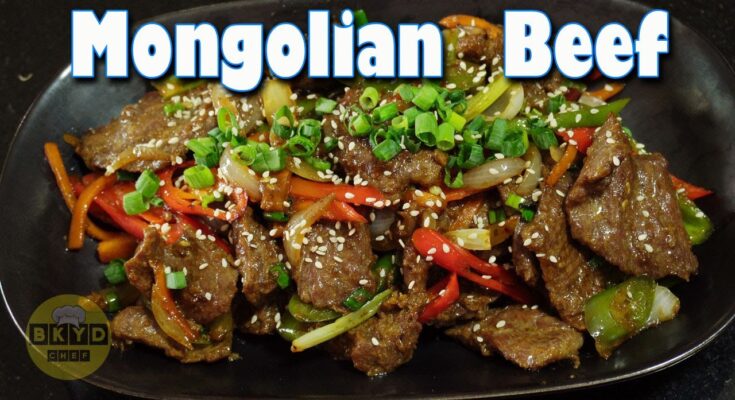Mongolian Beef Recipe: Mongolian Beef is one of the most popular dishes in Chinese-American cuisine, celebrated for its tender, flavorful beef coated in a sweet and savory sauce.
It’s the perfect balance of taste and texture, making it a go-to option for weeknight dinners and special occasions alike. While this dish often takes center stage at restaurants, it’s surprisingly easy to make at home with just a few simple ingredients.
Whether you’re new to cooking or a seasoned chef, this guide will walk you through each step to recreate this restaurant-style dish in your kitchen.
Ingredients Needed for Mongolian Beef
Main Ingredients
The key to a successful Mongolian Beef dish lies in selecting the freshest ingredients. Here’s what you’ll need:
- Beef: Opt for cuts like flank steak or sirloin. These cuts are tender and absorb the sauce beautifully when cooked correctly.
- Vegetables: Fresh garlic, ginger, and green onions are staples for an authentic flavor profile. Green onions not only add a mild oniony taste but also serve as a colorful garnish.
- Cooking Oil: High-smoke-point oils such as vegetable oil or peanut oil work best for stir-frying.
Sauce Ingredients
The signature sauce is the soul of Mongolian Beef, blending sweet, savory, and umami flavors. Gather these ingredients:
- Soy Sauce: Both light and dark soy sauce can be used for depth.
- Hoisin Sauce: Adds a touch of richness.
- Brown Sugar: This sweetener balances the salty soy sauce.
- Cornstarch: For thickening the sauce.
- Water: To adjust the consistency.
Optional Add-Ons
Want to elevate the dish? Consider these:
- Red Pepper Flakes or Chili Oil: Add some heat.
- Sesame Seeds: For a nutty crunch.
- Bell Peppers or Carrots: These can be stir-fried alongside the beef for added texture and nutrition.
Kitchen Equipment Essentials
Cooking Tools
The right tools make cooking Mongolian Beef a breeze:
- Wok or Large Skillet: These are ideal for stir-frying as they distribute heat evenly.
- Sharp Knife: A good knife ensures precision when slicing the beef thinly.
Measuring Tools
Accurate measurements are crucial in this recipe, especially for the sauce. Use measuring cups and spoons to ensure consistency.
Preparing the Beef
Choosing the Right Cut
Selecting the right beef cut is vital for tender results. Flank steak is the most common choice because it’s lean with a slight marbling, making it ideal for quick stir-frying. Sirloin or skirt steak can also be excellent alternatives.
Slicing the Beef
To achieve tender, evenly cooked beef:
- Slice against the grain. This breaks down muscle fibers, resulting in a softer texture.
- Aim for thin slices, about 1/8-inch thick, to allow quick cooking.
Pro Tip: Partially freeze the beef for 20–30 minutes before slicing. This firms it up, making it easier to cut.
Marinating the Beef
Marinating adds an extra layer of flavor and tenderizes the meat:
- Combine soy sauce, cornstarch, and a splash of oil in a bowl.
- Let the beef marinate for at least 15 minutes while you prepare other ingredients.
Making the Signature Sauce
Sauce Ingredients in Detail
The sauce’s complexity comes from its carefully balanced ingredients:
- Brown Sugar: Provides sweetness, offsetting the salty soy sauce.
- Soy Sauce Mix: A blend of light and dark soy sauce ensures a balanced flavor profile.
- Cornstarch Slurry: Mix 1 tablespoon of cornstarch with 2 tablespoons of water to create a thickening agent for the sauce.
Cooking the Sauce
To create the sauce:
- Heat a small saucepan over medium heat.
- Add soy sauce, brown sugar, and water. Stir until the sugar dissolves.
- Slowly add the cornstarch slurry, stirring constantly to avoid lumps.
- Simmer for 2–3 minutes until the sauce thickens to a glossy consistency. Adjust the taste with more sugar or soy sauce if needed.
Cooking the Mongolian Beef
Stir-Frying the Beef
Now that the beef is sliced and marinated, it’s time to cook it to perfection. Stir-frying is the key technique for Mongolian Beef, and it requires high heat and quick movements.
Steps:
- Heat a wok or large skillet over medium-high heat.
- Add 2–3 tablespoons of oil and let it get hot but not smoking.
- Place the beef in the skillet in a single layer. Cook for 1–2 minutes on each side until it’s browned but not fully cooked through. Avoid overcrowding the pan; if necessary, cook the beef in batches.
Tips:
- Don’t overcook the beef at this stage; it will finish cooking when combined with the sauce.
- Use tongs or a spatula to toss the beef for even browning.
Adding Vegetables
After the beef is cooked, remove it from the pan and set it aside. Add vegetables to the same skillet:
- Add minced garlic and ginger first, cooking for 30 seconds until fragrant.
- Toss in sliced green onions or any additional vegetables like bell peppers or carrots. Stir-fry for 1–2 minutes until they’re tender but still crisp.
Combining Beef with Sauce
The final step is bringing everything together:
- Return the cooked beef to the skillet with the vegetables.
- Pour the prepared sauce over the beef and vegetables.
- Toss everything together until the beef is evenly coated with the sauce. Let it simmer for 1–2 minutes to meld the flavors and thicken further.
Serving Suggestions
Best Accompaniments
Mongolian Beef pairs beautifully with a variety of sides. Here are some ideas:
- Steamed White Rice: The most classic pairing, as it absorbs the flavorful sauce perfectly.
- Fried Rice: For a more indulgent option, pair with egg or vegetable fried rice.
- Noodles: Stir-fried noodles or plain boiled noodles work wonderfully to complement the dish.
Garnishing Ideas
Finish your Mongolian Beef with a touch of flair:
- Green Onions: Sliced on the diagonal for a sophisticated look.
- Sesame Seeds: Sprinkle lightly for a nutty finish.
- Chili Flakes: For those who love a bit of heat.
Tips for the Perfect Mongolian Beef
Common Mistakes to Avoid
Even simple recipes can go sideways if you’re not careful. Avoid these common pitfalls:
- Overcrowding the Pan: This causes the beef to steam instead of sear. Cook in batches if needed.
- Skipping the Cornstarch: The cornstarch is essential for the sauce’s thick, glossy finish and helps coat the beef.
- Overcooking the Beef: Thin slices of beef cook quickly, so keep an eye on them to prevent a tough texture.
Adjusting to Taste
Make the dish your own by tweaking the ingredients:
- Sweeter Sauce: Add more brown sugar or a drizzle of honey.
- Spicier Flavor: Mix in chili paste or Sriracha sauce.
- Less Salty: Use low-sodium soy sauce or dilute with water.
Storing and Reheating
Proper Storage Techniques
If you have leftovers, you’re in luck! Mongolian Beef tastes even better the next day as the flavors deepen:
- Store in an airtight container in the refrigerator for up to 3 days.
- Allow the dish to cool completely before sealing to avoid condensation.
Reheating Tips
Reheating without losing the texture is crucial:
- Heat a skillet over medium heat and add a splash of water or beef broth to prevent drying out.
- Stir occasionally until warmed through.
- Avoid microwaving if possible, as it can make the beef rubbery.
Variations of Mongolian Beef
Vegetarian Options
For a meat-free version, substitute the beef with:
- Tofu: Use firm tofu, sliced and pan-fried for a crispy texture.
- Mushrooms: Portobello or shiitake mushrooms are excellent substitutes, providing a hearty bite.
Healthier Adjustments
Want to enjoy Mongolian Beef guilt-free? Consider these adjustments:
- Use leaner cuts of beef like tenderloin.
- Reduce the sugar in the sauce or use a natural sweetener like stevia.
- Stir-fry with minimal oil or opt for steaming the vegetables.
Spicy Mongolian Beef
If you love heat, try these spicy twists:
- Add Szechuan peppercorns for a numbing heat.
- Stir in chili oil or chopped fresh chilies for an extra kick.
FAQs About Mongolian Beef Recipe
What is Mongolian Beef?
Mongolian Beef is a popular Chinese-American dish made with tender slices of beef stir-fried in a savory and slightly sweet sauce, typically flavored with soy sauce, brown sugar, garlic, and ginger.
What cut of beef is best for Mongolian Beef?
Flank steak is commonly used for Mongolian Beef due to its tender texture and ability to absorb the flavors of the sauce. You can also use sirloin or skirt steak as alternatives.
How do I make Mongolian Beef tender?
To make the beef tender, slice it thinly against the grain and marinate it with a bit of cornstarch. This helps the beef stay juicy and prevents overcooking during stir-frying.
Can I add vegetables to Mongolian Beef?
Yes! Common additions include broccoli, bell peppers, or snap peas for added crunch and nutrition.
Is Mongolian Beef spicy?
Traditional Mongolian Beef is not overly spicy, but you can add red pepper flakes or chili paste if you prefer a spicy kick.
How can I serve Mongolian Beef?
Mongolian Beef pairs perfectly with steamed white rice, fried rice, or noodles. Garnish with green onions or sesame seeds for extra flavor and presentation.
Can I make Mongolian Beef ahead of time?
While best enjoyed fresh, you can prepare the sauce and slice the beef ahead of time. Store them separately in the refrigerator and cook when ready to serve.
Conclusion
Mongolian Beef is the ultimate crowd-pleaser—a dish that combines tender slices of beef, crispy vegetables, and a perfectly balanced sauce. With this step-by-step guide, you’ll master the art of making it at home, saving you time and money while impressing your family and friends. Whether served over rice or noodles, this recipe is bound to become a staple in your cooking repertoire.



